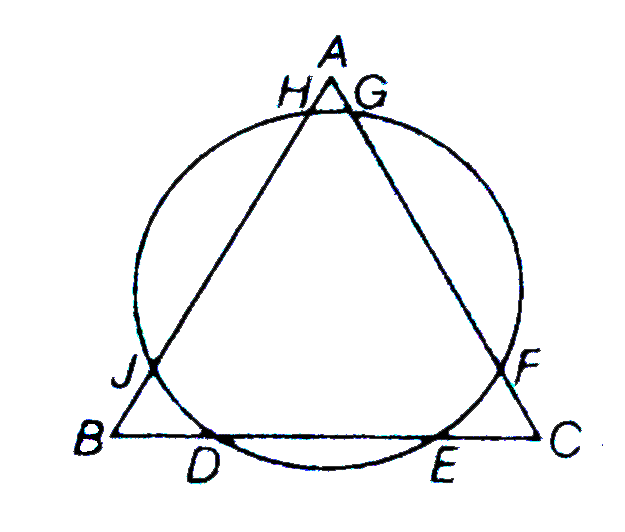If in a ΔABC, the incricle passing through the point of intersection of perpendicular bisector of sides BC, AB, then 4sinA2sinB2sinC2 equal to Solution in Punjabi
√2
√2−1
√2+1
12
The correct Answer is:B
Step by step video & image solution for If in a DeltaABC, the incricle passing through the point of intersection of perpendicular bisector of sides BC, AB, then 4 sin ""A/2sin ""B/2sin""C/2 equal to by Maths experts to help you in doubts & scoring excellent marks in Class 12 exams.
Topper's Solved these Questions
- BOOK - ARIHANT MATHSCHAPTER - PROPERTIES AND SOLUTION OF TRIANGLES EXERCISE - Exercise (More Than One Correct Option Type Questions)24videos
PROPERTIES AND SOLUTION OF TRIANGLES
- BOOK - ARIHANT MATHSCHAPTER - PROPERTIES AND SOLUTION OF TRIANGLES EXERCISE - Exercise (Statement I And Ii Type Questions)15videos
PROPERTIES AND SOLUTION OF TRIANGLES
- BOOK - ARIHANT MATHSCHAPTER - PROPERTIES AND SOLUTION OF TRIANGLES EXERCISE - PROPERTIES AND SOLUTIONS OF TRIANGLES EXERSISE 1: SINGLE OPTION CORRECT TYPE QUESTIONS1videos
PROPERTIES AND SOLUTION OF TRIANGLES
- BOOK - ARIHANT MATHSCHAPTER - PRODUCT OF VECTORSEXERCISE - Exercise (Questions Asked In Previous 13 Years Exam)52videos
PRODUCT OF VECTORS
- BOOK - ARIHANT MATHSCHAPTER - SEQUENCES AND SERIESEXERCISE - Exercise (Questions Asked In Previous 13 Years Exam)38videos
SEQUENCES AND SERIES
Similar Questions
If area of ΔABC(Δ) and angle C are given and if c opposite to given angle is minimum, then
03:52View SolutionIn a triangle ABC,a3+b3+c3=c2(a+b+c) (All symbol used have usual meaning in a triangle.) Statement-1: The value of ∠C=60∘. Statement-2: ΔABC must be equilateral.
02:21View SolutionIn the adjoining figure, the circle meets the sides of an equilateral triangle at six points.

If AG=2,GF=13,FC=1andHJ=7, then DE equals to03:57View SolutionLet O be the origin and let PQR be an arbitrary triangle. The point S is such that ¯¯¯¯¯¯OP⋅¯¯¯¯¯¯OQ+¯¯¯¯¯¯OR⋅¯¯¯¯¯¯OS=¯¯¯¯¯¯OR⋅¯¯¯¯¯¯OP+¯¯¯¯¯¯OQ⋅¯¯¯¯¯¯OS=¯¯¯¯¯¯OQ⋅¯¯¯¯¯¯OR+¯¯¯¯¯¯OP⋅¯¯¯¯¯¯OS Then the triangle PQR has S as its
02:47View SolutionLet a,b,c be in A.P. and |a|<1,|b|<1|c|<1.ifx=1+a+a2+....to ∞,y=1+b+b2+....to ∞and,z=1+c+c2+...to ∞, then x,y,z are in
03:20View SolutionIn ABC, the median AD divides ∠BAC such that ∠BAD:∠CAD=2:1 . Then cos(A3) is equal to sinB2sinC (b) sinC2sinB 2sinBsinC (d) noneofthese
09:15View SolutionIn any triangle ABC,sin2A−sin2B+sin2C is always equal to (A) 2sinAsinBcosC (B) 2sinAcosBsinC (C) 2sinAcosBcosC (D) 2sinAsinBsinC
02:08View Solution(2sin (AC) cos C-sin (A-2C)) / (2sin (BC) cos C-sin (B-2C)) = (sin A) / (sin B)
03:09View Solution(2sin (AC) cos C-sin (A-2C)) / (2sin (BC) cos C-sin (B-2C)) = (sin A) / (sin B)
02:28View Solution(sin (AC) + 2sin A + sin (A + C)) / (sin (BC) + 2sin B + sin (B + C)) is
12:33View SolutionInternal bisector of /_A of triangle ABC meets side BC at D. A line drawn through D perpendicular to AD intersects the side AC at E and the side AB at F. If a, b, c represent sides of DeltaABC, then
02:38View Solutioncos4A−sin4A is equal to 2cos2A+1 (b) 2cos2A−1 (c) 2sin2A−1 (d) 2sin2A+1
View Solutionयदि ΔABC कि भुजाएँ a,b,c समान्तर श्रेणी में हो, तो सिद्ध कीजिए कि-
2sinA2sinC2=sinB204:31View Solution2sinAsinB बराबर है|
View SolutionIn a triangle sin^(4)A + sin^(4)B + sin^(4)C = sin^(2)B sin^(2)C + 2sin^(2) C sin^(2)A + 2sin^(2)A sin^(2)B , then its angle A is equal to-
03:26View Solutionसमद्विबाहु ΔABC में यदि AB = AC और A से गुजरनेवाली रेखा AD, BC पर लंब हो तो सिद्ध करें कि D, भुजा BC को समद्विभाजित करेगा।
04:01View Solution

